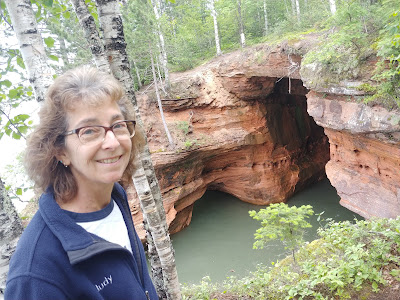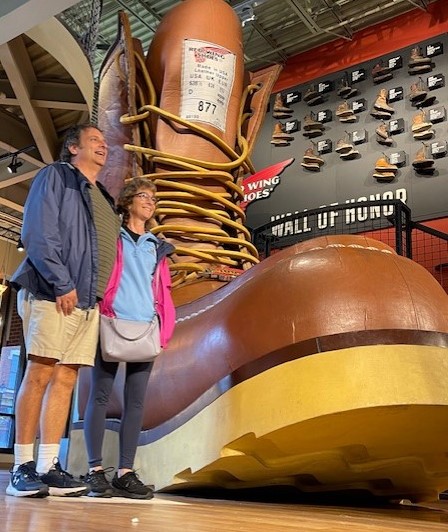We’re fully engaged in our 4-month trip to explore the Northern Rockies as we entered North Dakota, a state that neither Judy nor I have ever been to before. We’re pretty far north in the US, someplace around the 48th parallel. The days are longer! (I’m sure the winter days are shorter as well). That’s farther north than northern Maine, or even Seattle, Washington. The countryside is quite flat, and most of what we see are miles and miles of farm fields. And as the rest of the country suffers through a heatwave, we have managed to evade the worst of the heat, experiencing very warm days, but substantially cooler nights.
We’re staying at a state park on Grahams Island in the heart of the Spirit Lake Reservation. This Reservation is the domain of the Devils Lake Sioux Tribe, which, in the last 20 years, has been further clarified as descendants of the Mni Wakan Oyate tribe and recognized by the federal government. This stop gave us quite an education on the life of Native Americans in the latter half of the 19th century. European settlers and the American government at the time exploited the Native American population, expanded territory, forced the relocation of thousands, and broke many treaties in which Native Americans relinquished land for money, peace & security. One cannot help but be affected by the injustice illustrated in these museums about the plight of the Native Americans. There’s a common thread that seems to weave its way through our travels. That theme being “man’s inhumanity to fellow man”. Moving on.
The town of Fort Totten is just one of those places we visited where Native Americans were forced to give up their heritage and culture in order to assimilate into European civilized society. Fort Totten is a small town on the other side of Devils Lake, and the town is named after the US Army’s initial garrison of soldiers trying to keep the peace between the newly arriving, land-hungry European immigrants and the Indigenous Indian population. In the town of Fort Totten sits the original military outpost also called Fort Totten. The military post was built in 1867 and used continuously as a military reservation until 1890. Fort Totten, the military fort, became a Native American boarding school. A terrible place to send a child. For more than 80 years, spurred by federal assimilation policies beginning in the early 19th century, Native American children were sent to schools like the Fort Totten boarding school, and in some cases, they were forcibly removed from their homes. Not allowed to speak their native language, every effort was made to remove the Indian heritage from the children. Many children faced beatings, malnutrition, hard labor, and other forms of neglect and abuse. Some never returned to their families. Some ran away, never to return. The schools were organized as military style trade schools, designed to teach skills like sewing, leather work, agriculture, carpentry, printing, and cooking. The popular guiding principal of the time was to “Kill the Indian in him and save the man.” If this sounds like an ugly policy, well, it was. Honestly, we were a bit upset and dismayed at the cruelty shown to those innocent children. In the 1930’s the treatment of the children and the objectives of the school changed significantly and was more in line with modern educational principles. The Fort Totten Boarding School eventually closed in the 1950s. We spent a while at the museum and eventually museum personnel tracked us down in one of the buildings to let us know it was time to leave, as the museum was closing.
 |
| Historically Accurate Commissary at Fort Totten |
The Grahams
Island Campground, on Devils Lake, where we are staying, is probably one of the
nicest state parks we have visited so far. My gosh, this area is beautiful! There
is a lot of boating, and I understand the walleye, perch, and northern pike
fishing is outstanding. And it must be, because the state park has a couple of
fish cleaning stations and they were very, very busy. The park’s rolling hill landscape
was covered with great shade trees, and there was a beach on the lake for
swimming. Primarily, what we thought was so fantastic was the space we had at
our campsite. During the week the next closest occupied campsite was probably
200 feet away. We had some lovely nights by the campfire, and we had enough
space to stretch out the hammock between two Cottonwood trees. And the “price paid” for the space to relax
was the approximately13-mile drive to get to, what anyone would consider,
civilization. And that civilization was the
City of Devils Lake.
We spent a very hot day wandering the 5-block area known as the town center. There were a couple of museums on our radar, and we needed to find the post office, so we parked the truck and started walking. The best museum in an air-conditioned building was the impressive old Ramsey County Courthouse building which held the Lake Region Heritage Center. This place was one part museum, and two parts a collection of town artifacts and antiquities strewn across the building, loosely arranged by subject. What was so unusual is that we were encouraged to touch anything we wanted and to take a closer look. For example, we were allowed to flip through a collection of the town newspapers from 1942. Very delicately so as not to disturb the newsprint. There were some really interesting historical articles about the war effort and war bond purchases as well as a slew of agriculturally based advertisements. And there was this disturbing yet intriguing article about cows being born, one inside out and one with two heads.
Take a look at the short clip of Judy
operating and listening to a 1914 Victrola. The music is a little foreign to
us, but the 110-year-old contraption was initially hand cranked before the album
played. All in all, a very interesting
county historical museum.
We were not done visiting county historical museums. Devils Island is located in Ramsey County, and across the lake lies the town of Lakota, which is in Nelson County. The Historical Society of Nelson County operates a make-believe town called “Stump Lake Village Pioneer Museum”. This historical museum had a bit of everything. Old cars, chuck-wagon from the old west, tons of old farm equipment including a large collection of antique tractors, most of which were still working. This county had preserved an entire dentist office from the 1940’s. As you will see below, I stepped into a phone booth to make an important call on my cell phone. LOL.
 |
| Stump Lake Village Pioneer Museum Antique Barn |
 |
| Sitting on an Antique Tractor |
 |
| Sitting in Caboose railcar at Stump Lake Village |
There is so much to
chronicle from our stop in Devils Lake, ND, including an excursion to a nature
preserve and an encounter with a herd of Bison. But my word count is growing,
and there’s only so much my readers can take.😉 So I’ll close with just one more tale of
adventure.
There is a certain pleasure in stumbling into an establishment, on a whim, at a propitious time, and discovering something new. It can be a “hit or miss” experience, but we found a big hit in Devils Lake. It was a very hot afternoon and we walked through the city center, trying to stay on the shady side of the street. We passed an interesting Micro-Brewing storefront, and it looked like it had just opened for the day. The space was airconditioned and we were well in need of something cold to drink and a snack. Upon entering we were met by the owner and brew master of Black Paws Brewery, and his oversized Newfoundland dog, Marco. And, gosh darn it, Marco, was just an adorable, big, lovable dog. We were encouraged to sit at the bar as we were the first patrons of the afternoon, taste some micro-brewed beer and seltzer, and try the brisket nachos. We lost track of time as we talked with the owners and the other patrons who filtered in slowly through the afternoon. It was wonderful and we got some great suggestions on thing to do. The best suggestion we got was from a young man sitting at a table behind us about the local theater company putting on a play in the outdoor theater in Devils Lake. No big surprise here, we went! Got to see the “Wedding Singer”, a musical, performed by the local summer stock theater company, at a delightful outdoor stage with lawn seating. Now that was a win, and then another win! Grahams Island State Park was a relaxing and enjoyable stop. Filled with sun, space, antique tractors, a couple of heritage museums, with a slice of theater on the side. Let’s see what happens on our next stop, as we tell… the Rest of the Story.
 |
| Fort Totten Little Theatre, The Wedding Singer |




























